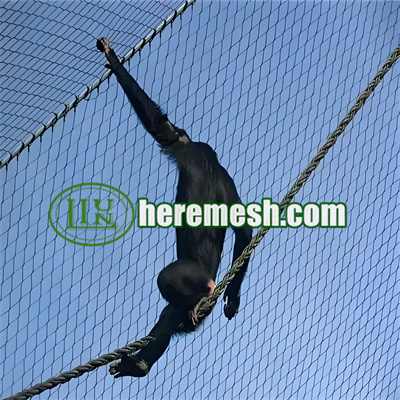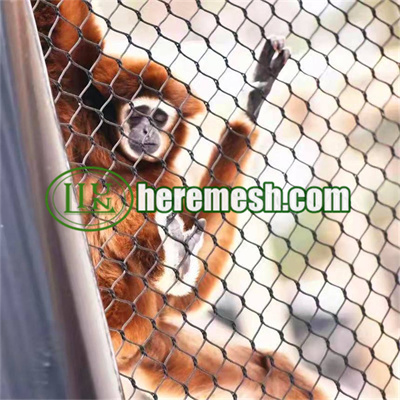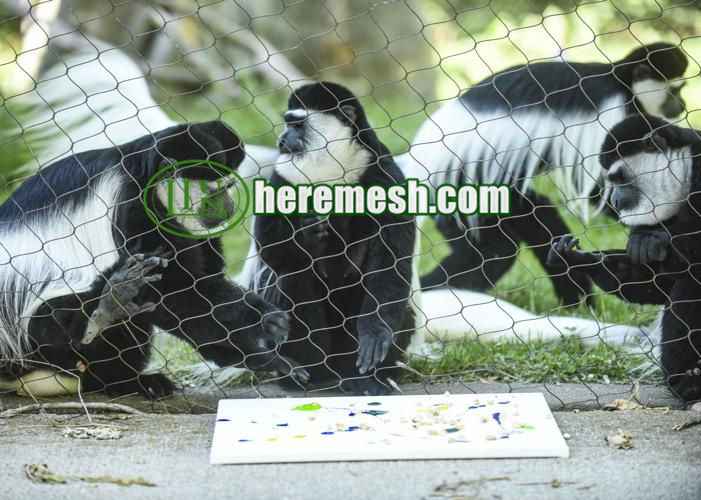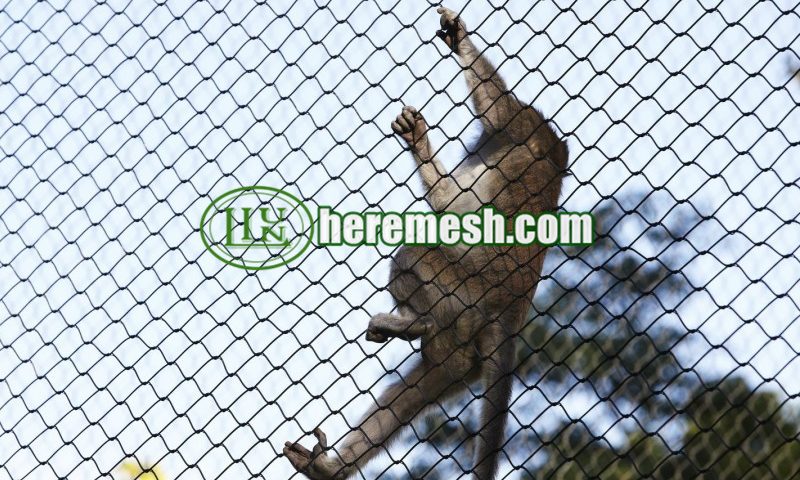Safety Barrier for Primates: Gibbon Cage Fence

Ferrule Mesh for Kea Aviary Order Shipping
08/18/2025
Order Delivery to Switzerland: Terrace Anti-fall Mesh
09/02/2025In the ecological system of a zoo, gibbons have become a favorite primate among visitors. Creating a suitable habitat for gibbons ensures their physical and mental well-being. A safe and comfortable enclosure better reflects the modern zoo’s philosophy of “animal welfare first.” Among the various materials used in enclosure construction, stainless steel rope netting has emerged as an ideal choice for gibbon cage fence due to its unique performance advantages. This article will analyze the core advantages of stainless steel rope netting in gibbon fence applications from the perspective of their ecological habits, exploring its significant value in ensuring animal safety, simulating natural habitats, and simplifying management and maintenance.
1. Gibbons: Ecology and cage fence Needs
Gibbons are a typical representative of primates. Their physiological structure and behavioral habits impose stringent requirements on their habitat environment. Understanding these characteristics is a prerequisite for selecting appropriate cage materials.
Gibbons have a slender build, with forelimbs significantly longer than hindlimbs. This unique body structure enables them to swing freely through the trees. In their natural habitats, they require extensive daily activity space for foraging, socializing, and marking territories, with a wide range of movement. Additionally, gibbons possess highly flexible fingertips and palms, enabling them to excel at grasping and climbing. They are also sensitive to the safety and openness of their environment; confined or oppressive spaces can trigger stress responses.
Based on these habits, gibbon enclosure design must meet three core requirements:
• Adequate freedom of movement:
Gibbon cage fence must provide animals with sufficient vertical and horizontal space. A spacious environment allows them to engage in natural behaviors such as swinging, climbing, and jumping, thereby preventing behavioral abnormalities caused by restricted space.
• High safety standards:
Cage fence materials must possess sufficient strength and durability to withstand the gibbons’ grasping, pulling, and colliding. Smooth rope net surfaces help prevent sharp edges or other hazards that could injure the animals.
• Naturalized environmental simulation:
Cages should replicate gibbons’ natural habitats as closely as possible. Good lighting, ventilation, and integration with natural elements like trees and vines help minimize the impact of artificial environments on their physiology and psychology.
Traditional materials such as wire mesh and glass often have significant limitations when it comes to meeting these requirements. Wire mesh is prone to rust, lacks sufficient strength, and may cause gibbons’ limbs to become stuck. While glass provides good visibility, it lacks ventilation and cannot provide gibbons with grip points, making it difficult to meet their climbing needs. In contrast, stainless steel rope mesh, with its material properties and structural advantages, can better accommodate the design requirements of gibbon cage fence.


2. Safety first: Stainless steel netting in gibbon cage fence
• Durable against gibbon forces
Gibbons frequently exert pulling and impact forces on the mesh panels during their activities. An adult gibbon’s arm strength can reach several times its body weight. When swinging or leaping, the instantaneous pulling force on the mesh often reaches hundreds of kilograms. Gibbon cage fence is woven from high-strength stainless steel wire, enabling the entire mesh panel to withstand enormous loads.(304 stainless or 316 stainless steel )
Take 304 stainless steel as an example, this material endows the mesh with exceptional mechanical strength and toughness. Even with repeated gripping and pulling by gibbons, the mesh remains resistant to breakage or deformation. Additionally, the stainless steel rope mesh employs a specialized weaving technique that creates a robust, tightly knit structure. This design eliminates the weakness of traditional welded wire mesh joints prone to fracture, ensuring the mesh maintains structural integrity over extended use.
• Resists corrosion in challenging conditions
Gibbon cage fence often present complex environmental challenges. Enclosure netting must withstand exposure to wind, sun, rain, snow, and other natural elements, while also coming into contact with corrosive substances like gibbon excrement. Ordinary metal materials are highly susceptible to rusting in such conditions, significantly shortening their service life. Rust particles may also be accidentally ingested by gibbons, posing health risks.
The corrosion resistance of stainless steel rope netting represents another major advantage. 304 stainless steel exhibits excellent corrosion resistance, maintaining a bright, new appearance over extended periods in dry, clean environments. 316 stainless steel, enhanced with molybdenum, offers even superior corrosion resistance. It effectively resists rust even in highly corrosive environments like humid, foggy, or coastal areas. When used in gibbon cage fence, stainless steel rope netting eliminates the need for frequent anti-corrosion treatments, significantly reducing safety hazards associated with material corrosion.
• Protects gibbons during activity
During activities, animal skin frequently comes into direct contact with enclosure materials, making their safety paramount. Traditional wire mesh often features sharp burrs or protrusions at its knots, which can easily scratch gibbon skin. Additionally, when coatings peel off certain metal surfaces, they may release harmful substances.
Stainless steel rope netting is designed and manufactured with animal safety as a primary consideration. The wires in the mesh undergo special treatment to achieve a smooth, burr-free surface, preventing skin abrasions in gibbons. Additionally, stainless steel itself is chemically stable and does not release harmful substances. Even if gibbons chew on the mesh (especially juveniles), it poses no health risk. Furthermore, mesh aperture sizes can be customized to gorilla body dimensions (typically 50mm-100mm apertures), preventing limb entrapment while maintaining unobstructed vision and mobility.


3. Gibbon cage fence: Flexible design, natural habitats
Beyond its material properties, the structural design of stainless steel rope netting offers unparalleled advantages in simulating gibbons’ natural habitats. It seamlessly integrates with natural elements within enclosures, creating a safe and vibrant living environment for gibbons.
• Maximizes natural light and air
In their natural habitats, gibbons inhabit the sunlit, well-ventilated canopy layers of forests. Inadequate lighting or poor ventilation in enclosures can lead to health issues for gibbons. Stainless steel gibbon cage fence features an open mesh structure with exceptional permeability, maximizing natural light penetration within the enclosure. Sunlight filters evenly through the mesh, satisfying gibbons’ physiological need for light while promoting plant growth within the enclosure and creating a more natural ecological atmosphere.
Excellent ventilation is another key advantage of stainless steel rope netting. Air circulates freely through the mesh, effectively reducing humidity within the enclosure and minimizing bacterial and fungal growth. During hot summer weather, this well-ventilated environment helps gibbons dissipate heat and prevents heatstroke. In winter, strategic netting placement maintains ventilation while reducing direct exposure to winds, providing a comfortable environment for the gibbons.
• Adaptable for enriched behaviors
Gibbons exhibit diverse activity patterns, necessitating enclosure designs with complex and adaptable spatial structures. Stainless steel mesh offers exceptional flexibility, allowing it to be fabricated into various shapes and sizes according to enclosure requirements.
For instance, vertically within enclosures, stainless steel rope netting can form “climbing walls” with wooden poles fixed to simulate branches, providing gibbons with climbing footholds. Horizontally, the mesh can form passageways, allowing gibbons to move freely between different areas. This diverse spatial design not only meets their activity needs but also stimulates exploratory behavior, reducing the occurrence of stereotypical behaviors.
Furthermore, the flexibility of stainless steel rope mesh allows it to adapt to varying terrain. For enclosures built against hillsides or incorporating natural topography, the mesh can be laid to follow the contours of the land. This feature avoids the disruption of natural landscapes caused by leveling the ground, helping to recreate authentic habitat conditions for the animals.
• Visually neutral to reduce stress
Gibbons are highly sensitive to visual stimuli in their environment, and overly conspicuous artificial structures can induce negative emotions such as tension and anxiety. Stainless steel gibbon cage fence mesh can be customized with black oxide coating. Its natural black hue blends seamlessly with surrounding trees, vegetation, and other natural elements, visually softening the boundaries of artificial enclosures.
When viewed from outside, the stainless steel cable mesh avoids the glare of glass and the harsh appearance of wire fencing, allowing visitors clearer observation of gibbons’ natural behaviors. From the gibbons’ perspective, the mesh’s transparency enables them to see the environment beyond the enclosure, reducing the oppressive feeling of confinement. This visual integration helps gibbons maintain a calm state of mind, enhancing their overall welfare.
4.Conclusion: Guardians of gibbon agility and freedom
The survival status of gibbons is closely tied to their habitat conditions. In zoo management, providing them with safe, comfortable, and natural-like enclosures is the responsibility of every professional. Stainless steel rope netting offers multiple advantages—high strength, corrosion resistance, high transparency, and easy maintenance—making it an ideal choice for constructing gibbon cage fence.
It serves not only as a physical safety barrier but also as a bridge connecting the artificial environment to their natural habitat. This solution ensures the gibbons’ activity safety while satisfying their need for freedom and exploration, simultaneously streamlining zoo management. With ongoing technological advancements, stainless steel rope netting will continue to be optimized in both material and craftsmanship, contributing significantly to enhancing the welfare of primates like gibbons.
If you are interested in stainless steel gibbon enclosure mesh, please contact us:
Email:[email protected]/[email protected]
Website:www.heremesh.com


